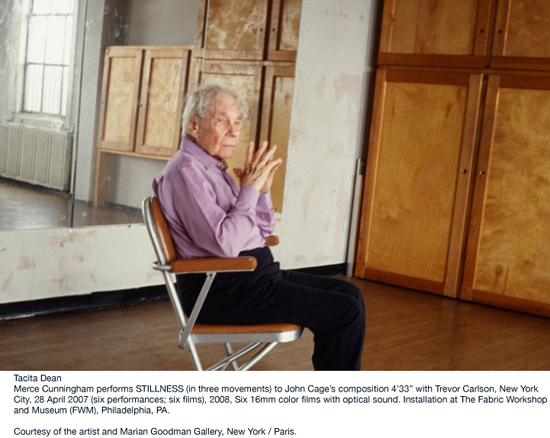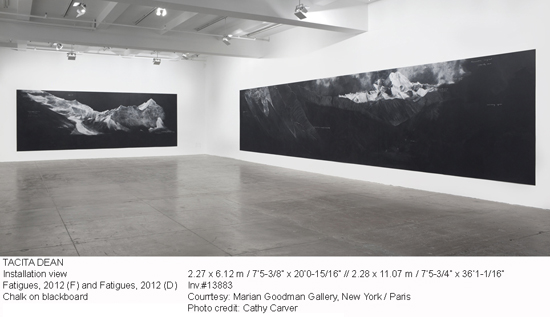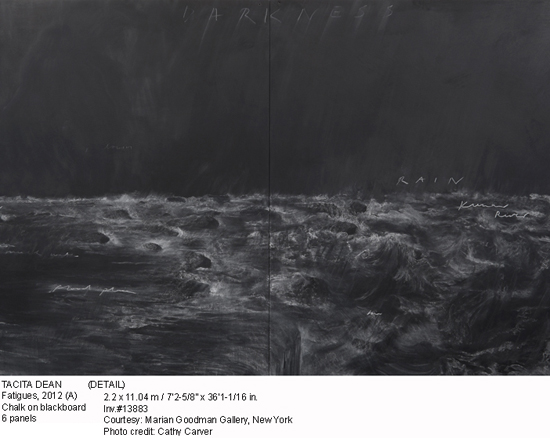Shows surveyed in this essay:
1. Merce Cunningham performs STILLNESS (in three movements) to John Cage's composition 4'33" with Trevor Carlson, New York City, 28 April 2007 (six performances; six films), 2008, at The Fabric Workshop Museum, Philadelphia, through March 17, 2013
2. Fatigues, 2012 at Marian Goodman gallery, NYC, through March 9, 2013
3. JG, 2013, at Arcadia University Art Gallery, Glenside, PA, through April 21, 2013
Part 1:
"It's film! Film! 16 mm film!' Tacita Dean shouted from the front row of So Percussion's performance at The Fabric Workshop in Philadelphia, a few Saturdays ago. It was the opening night of her show there, and the quartet's Josh Quillen was saying how honored they were to play at the opening of the great video installation upstairs. Oops.
Tacita Dean is an artist working in what she terms a medium going extinct. You can't really learn about Dean without learning about film's imminent demise in the age of digital media. The artist has become an activist for the preservation of film production and display by necessity. As she says in an as of yet unpublished essay: "I am 46 but picked a medium at art school that looks unlikely to outlast my career". She has also chosen to work in chalk dust and to chase eclipses.
While the downstairs of The Fabric Workshop was filled to capacity with opening night attendees straining their ears to hear Dean's talk and the percussion quartet's performance, Merce Cunningham was pretty much by himself upstairs, dancing to his long-dead lover's most famous score by being as still as he possibly could, for four minutes and thirty-three seconds. The film was made in 2008, a year before Cunningham died. Dean asked him if he would make a dance response to Cage's 4'33" especially for her camera. He agreed, but did not share with her his plans for it. When she finally arrived at his studio, she and her small crew sat down to watch him perform his dance for the first time while their two cameras were rolling. She shot Cunningham for Stillness six times. The dance is a physical tribute to silence; Cunningham only moves when he changes seated position slightly for each of Cage's original three movements. Although these were meant to be six takes to later be whittled down to the preferred performance for the film, Dean realized she was instead witnessing six different performances, and decided to include all of them.

Dean is known for letting her camera stay still for long stretches: "I prefer to wait for it," she told The New Yorker. It is a tactic she usually uses for natural phenomena fleeting in nature; an eclipse or a seldom-seen optical effect of sunsets (Banewl, 1999 and The Green Ray, 2001, respectively). It is nice to think of Merce Cunningham as natural phenomena, to be witnessed and not tampered with in the editing room. Having watched the performances for the first and only time while filming the dance must have put Dean in the same state of mind she was in when chasing the green ray--if you are lucky enough to have it front of you with the camera rolling, don't mess with it. Dean extends the same ethos to the installation of Stillness. In the two incarnations I have seen (in Philadelphia at FWM and at Dia:Beacon in 2008) Merce's celluloid image is projected exactly life-sized, and the screens are arranged on the gallery floor, placing him at his correct height from the ground.
Part 2:
"... if only one could unwind this spiral it would play back to us a picture of all the landscapes it's ever seen..." (excerpt from voice-over narration, JG)

JG is Tacita Dean's latest work. It was commissioned by and made for the Arcadia University Art Gallery and funded in part by the Pew Foundation. It is named after J. G. Ballard, the science fiction writer, and has Robert Smithson's Spiral Jetty at its heart. The connection between Ballard, Dean and Smithson traverses time, space, and artistic media. It all began one day while visiting New York in 1997. Dean mentioned to someone she was going to Utah, and was told, "You're going to Utah? I hear the Spiral Jetty has risen!" Her first failed attempt to locate the Jetty that year was the seed that would later grow not only into a "pilgrim's zeal as if for a splinter of the cross," for finding Smithson's work, but also into a friendship and correspondence with Ballard (whose short 1960 story The Voices of Time, in which a scientist builds a cement mandala in the middle of a salt bed, may or may not have been the inspiration for the Spiral Jetty itself) and finally, led to the completion of JG in 2012.
If Merce Cunningham Performs... is about not messing with what's in front of the camera, JG is all about the fantastical potential for in-camera intervention on film. It was made using the same technique as Film, Dean's 2011 commission for one the world's largest art spaces, the Turbine Hall at Tate Modern, London. In comparison, JG at Arcadia is an intimately-sized portrait of the immeasurably larger American landscape in which Smithson worked. Like Film, JG was shot in anamorphic color and black-and-white 35 mm film using a method Dean developed (and patented). This technique allows Dean to insert tiny 3D-printed stencils, less than a millimeter thick, into the camera's gate, only exposing certain parts of the film as it goes through the camera. She then puts in a new stencil and runs the same film through, this time exposing it through a different mask, creating unique moving collages.

I asked Dean, "Why patent this?". It seems odd, considering the whole medium is on the edge of extinction, and that there is no "big bucks" potential for this very specific, very art-related technique (unless, maybe, you are Tacita Dean). Is it more personal than that? A way to stake her claim on some part of the film-making medium, using a legal-financial mechanism as a way to say "I was here"? She responded: "Of course the patent is financially useless. It was more about acknowledging what a potentially exciting technique this is as a way to make films, if everyone wasn't so blinded by digital, but of course it can be copied visually digitally in a faux analogue way which people may not care to do but then there is a desire to imitate and vanquish film going on out there, and the patent wouldn't even cover that anyway." She added later: "Most importantly it was because I was involved in inventing something!"
JG is not only a film collage made inside the camera, it is also a collage of influences filled with quotations of Ballard and Smithson, both visual and spoken. It is better to have read Ballard's story before seeing the film. When the narrator is heard saying "I'm sorry, Robert. What can I say, even the sun is growing cooler," you will discern there are two Roberts: Robert Smithson as well as Robert Powers, Ballard's protagonist. The masks Dean created for this work are also quotations: a Spiral Jetty mask is overlaid on footage of the water above the actual submerged jetty; the cryptic trapezoid recalling a swimming pool in perspective is a quote from Ballard's story, which in turn originated from traumatic events in Ballard's childhood. The film's sound was digitally recorded, and it forms another layer of quotation. It includes sounds from the sites, sounds of film being projected, and voice-over narration. The script is comprised entirely of quotes from Ballard's short stories, his writing about Smithson, and his correspondence with Dean. Time itself is used as punctuation, dividing the film into its 5 sections; an image of a wall-mounted analog clock is accompanied by the narrator's voice telling the time, all taken directly from Ballard's story.
Part 3:
"...all the things I am attracted to are just about to disappear." (Tacita Dean, interview with The New Yorker, Oct. 2012)
Seeing a show in 2013 is usually a zoom-in process, and Fatigues was no exception. I first saw it online. The jpegs displayed on my personal light box offered no sense of the scale of the chalk-on-blackboard drawings they represented, but they looked grand: mist rolling off massifs of darkness, negative black space turned into the substance of mountains, and the white powder of the peaks' snow, lifting itself effortlessly into the atmosphere. Then, from a distance of thirty feet, standing at the doors of Marian Goodman Gallery, I got the scale. The drawings are multi-paneled giants, much taller than a person, each spanning the length of the wall on which it is hung. I heard Dean is slowly losing her fingerprints to the arduous process of their creation. There's a bit of awe in seeing them; their sheer size and panoramic scale makes you feel like you are surveying a landscape, not a drawing. Standing close-up brings inevitable disappointment: the lame dryness and matter-of-factness of "just" chalk. That's all it is? Not ozone and snow and magic, just classroom dust? Herein lies the greatness of this piece and what connects it back to Dean's main medium of film. We knew all along, just like we know when we sit down to watch a movie, ready to believe, to happily go along with these games of light and shadow.


Fatigues refers both to military uniform and to the state Dean was in when completing the Tate commission. Dean's process itself being a spiral, it is no great surprise to learn that she chose to return to chalk, which she hadn't used for a decade due to an occurrence in the editing room for Film. Utilizing matte glass painting, an old special-effects method from early cinema, Dean made a hyper-realistic painting of Mount Analogue, a mythic mountain described in an eponymous 1950's French Surrealist novel and said to be "...perceived by realizing that one has traveled further in traversing it than one would have by traveling in a straight line, and can only be viewed from a particular point when the sun's rays hit the earth at a certain angle." Another source of the work's genesis was an attempt by Dean to make a "blind" film of the Hindu Kush mountain region in Afghanistan, directing a cameraman from long-distance and then editing the footage herself. The film project failed under unclear circumstances, but some of the drawings are based on its damaged film stock.
An unsung hero of this show is tucked (as much as a piece its size can be tucked) behind a column in the back room of the gallery. This almost empty, heartbreakingly hilarious piece has only some faint, erased marks on it, and the words "flash flood" hurriedly jotted in the corner.
The image of the mandala is mirrored in Dean's work both in form (the jetty) and in intent. Seeing that the works at Marian Goodman were made in Kassel for dOCUMENTA 13, the first thing I asked the gallery attendant was: "how is it possible to get these from Germany to NYC without smudging?" The answer: it isn't possible. The works were indeed smudged in transit, and Dean restored them in the gallery. She does not allow for the works to be treated with fixative. Firstly, as anyone who's worked with drawing knows, it would change the appearance of the work, possibly destroying it, and even if it didn't, I suspect Dean would have not allowed it anyway. Like a Buddhist sand mandala, painstakingly made in dust only to be blown away in the end as a sign of life's own transitory nature, Dean's drawings are about their own demise, and they would not have the same meaning without it.
Standing in stark contrast to the giant drawings is The Friar's Doodle (2010). Projected onto a small glass screen hovering in the middle of a side room between the two large galleries, this meditative piece comes from a drawing given to Dean when she was a teenager by a Franciscan friar. Having saved it for decades, Dean finally made it the subject of this explorative, intimate portrait, which never looks up from the page and never even zooms out enough to allow us to see the entire page. Instead, it follows the lines and whorls of the monk's drawing, like the limited perspective of a man in a labyrinth. The only sound in the room is the projector's purr, as it endlessly loops the 16 mm film.
Part 4:
Tacita Dean is a regrettably rare example of an artist who writes about her own work in what I can most succinctly describe as the antidote for an e-flux press release. (Although J.G Ballard said of Dean: "Tacita writes well--perhaps too well for an artist."). These texts, which Dean sometimes calls "asides," form the basis of the explanatory mechanism surrounding each of her projects. The publications that accompany her work are related to it in terms of goals and formalistic structure. Tate Modern's catalog for Film was composed entirely of texts calling for the preservation of film and featured writings by participants ranging from Keanu Reeves to Thomas Demand. The texts comprising the exquisite catalog produced for JG have a daisy-chain effect: written years and continents apart, each text recalls the one that follows it. They include J. G. Ballard's essay (containing the most flattering comparison between artists and mental patients I have ever read), personal letters between him and Dean, and Smithson's own Spiral Jetty text. Filled with film-stills from JG, the catalog ends with the image of the last photograph Ballard ever took but never saw, stuck on his broken camera and given to Dean after his death, which she fixed and continued to use.
Will we be able to see Tacita Dean's work, first hand, in 100 years? To date, the 46 year-old artist's major works are mostly in film and chalk dust. Consider Dean's subjects, too: a dancer who no longer is moving, a spiral jetty that sinks out of sight, a flash flood so powerful it threatens to erase the world. Dean's work bespeaks its own demise. In a world saturated with information and seemingly endless storage space for it, it is a reminder of how much is being rapidly lost. Until then, go see the shows while they are still up.

This article was published in Title Magazine on February 28, 2013.